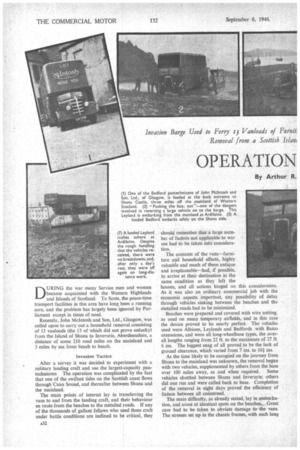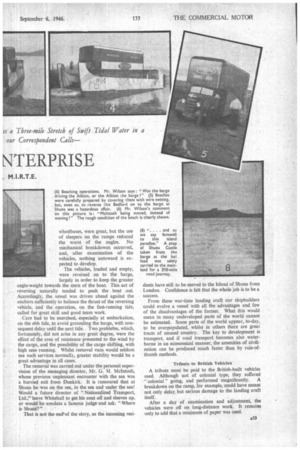OPERATION TERPRISE
Page 34

Page 35

If you've noticed an error in this article please click here to report it so we can fix it.
By Arthur R. M.I.R.T.E.
DURING the war many Service men and women became acquainted with the Western Highlands and Islands of Scotland. To Scots, the peace-time transport facilities in this area have long been a running sore, and the problem has largely been ignored by Parliament except in times of need.
Recently, John McIntosh and Son, Ltd., Glasgow, was called upon to carry out a household removal consisting of 13 vanloads (the 13 of which did not prove unlucky) from the Island of Shuna to Inverurie, Aberdeenshire, a distance of some 210 road miles on the mainland and 3 miles by sea from beach to beach.
Invasion Tactics After a survey it was decided to experiment with a military landing craft and use the largest-capacity pantechnicons The operation was complicated by the fact that one of the swiftest tides on the Scottish coast flows through Cuan Sound, and thereafter between Shuna and the mainland.
The main points of interest lay in transferring the vans to and from the landing craft, and their behaviour en route from the beaches to the metalled roads. If any of the thousands of gallant fellows who used these craft under battle conditions are inclined to be critical, they should remember that a large number of factors not applicable to war use had to be taken into consideration.
The contents of the vans—furniture and household effects, highly valuable and much of them antique and irreplaceable—had, if possible, to arrive at their destination in the same condition as they left the houses, and all actions hinged on this consideration. As it was also an ordinary commercial job with the economic aspects important, any possibility of delay through vehicles sinking between the beaches and the metalled roads had to be minimized.
Beaches were prepared and covered with wire netting, as used on many temporary airfields, and in this case the device proved to be nearly perfect. The vehicles used were, Albions, Leylands and Bedfords with Baico extensions, and were all long-wheelbase types, the overall lengths ranging from 22 ft. to the maximum of 27 ft. 6 ins. The biggest snag of all proved to be the lack of ground clearance, which varied from 7 ins. to 10-1 ins.
As the time likely to be occupied on the journey from Shuna to the mainland was unknown, the removal began with two vehicles, supplemented by others from the base over 100 miles away, as and when required. Some vehicles shuttled between Shuna and Inverurie; others did one run and were called back to base. Completion of the removal in eight days proved the efficiency of liaison between all concerned.
The main difficulty, as already stated, lay in embarkation, and arose at identical spots on the beaches.. Great care had to be taken to obviate damage to the vans. The stresses set up in the chassis frames, with such long wheelbases, were great, but the use of sleepers on the ramps reduced the worst of the angles. No mechanical breakdowns occurred, and, after examination of the vehicles, nothing untoward is expected to develop.
The vehicles, loaded and empty, were reversed on to the barge, largely in order to keep the greater angle-weight towards the stern of the boat. This act of reversing naturally tended to push the boat out.
Accordingly, the vessel was driven ahead against the anchors sufficiently to balance the thrust of the reversing vehicle, and the operation, on the fast-running tide, called for great skill and good team work.
Care had to be exercised, especially at embarkation, on the ebb tide, to avoid grounding the barge, with con sequent delay until the next tide. Two problefns, which, fortunately, did not arise in any great degree, were the effect of the area of resistance presented to the wind by the cargo, and the possibility of the cargo shifting, with high seas running. Whilst removal vans would seldom use such services normally, greater Stability would be a great advantage in all cases.
The removal was carried out under the personal supervision of the managing director, Mr. G. M. McIntosh, whose previous unpleasant encounter with the sea was a hurried exit from Dunkirk. It is rumoured that at Shuna he was on the sea, in the sea and under the sea!
Would a future director of "Nationalized Transport, Ltd." leave Whitehall to get his coat off and sleeves up, or would he emulate a famous judge and ask: "Where is Shuna?"
That is not the encrof the story, as the incoming resi dents have still to be moved to the Island of Shuna from London. Confidence is felt that the whole job is to be a success.
From these war-time landing craft our shipbuilders could evolve a vessel with all the advantages and few of the disadvantages of the former. What this would mean in many undeveloped parts of the world cannot be estimated. Some parts of the world appear, to-day, to be overpopulated, whilst in others there are great tracts of unused country. The key to development is transport, and if road transport becomes also waterborne in an economical manner, the amenities of civilization can be produced much faster than by rule-ofthumb methods.
Tribute to British Vehicles
A tribute must be paid to the British-built vehicles used. Although not of colonial type, they suffered " colonial " going, and performed magnificently. A breakdown on the ramp, for example, could have meant not only delay but serious damage to the landing craft itself.
After a day of examination and adjustment, the vehicles were off on long-distance work. It remains only to add that a minimum of paper was used.




































































